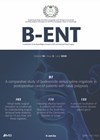
Journal Reviews
Nasal function in COVID-19 patients
This Turkish prospective study compared SNOT-22 outcomes as well as objective assessments of nasal secretion and clearance in 40 patients who tested positive on COVID-19 antigen PCR testing and 40 patients who tested negative. Sinonasal findings were assessed using a...
An inherited platelet disorder in a post- tonsillectomy haemorrhage
Unexplained bleeding after any surgery is least desirable and to identify a cause for this preoperatively can be a very useful safeguarding measure. By looking for inherited platelet disorders in patients who bled after tonsillectomy, the authors of this publication...
The vitamin D deficiency and recurrent BPPV debate revisited
The role of calcium metabolism and disorders of bone mineral density in the evolution and recurrence of BPPV has been debated over the years. As a contribution to this debate, the authors undertook a prospective study into the correlation between...
‘Acoustic shock’
Development of hearing loss due to traditional and steady state noise in working environments has well defined medical, physical and legal implications in the present times. Organisations not complying with ‘Noise at Work Regulations 1989’ are liable for compensation if...
Modifying two-week wait protocol for suspected head and neck cancer patients during COVID-19
As healthcare workers, we are committed to ensuring that our patients continue to receive the optimum care that we are set up to deliver. However, the last year has shown that we need to be mindful of balancing this with...
Effect of stimulation levels on speech recognition and auditory threshold performance
When programming a Cochlear® device, two measurements are normally assessed. T levels relate to the quietest sound the CI user can hear i.e. thresholds, and C levels are comfortable levels which are tolerable for the CI user. If these levels...
Predictors of diabetes insipidus post-hypophysectomy
Transient diabetes insipidus (DI) after pituitary surgery is not uncommon and its diagnosis fairly obvious. Permanent DI is rare and often depends on the neurosurgeon’s experience. This retrospective study describes a large series of patients with majority undergoing endoscopic transsphenoidal...
Cuff up or cuff down; to occlude or not to occlude? What effect does tracheostomy tube modification have on swallowing outcomes?
Dysphagia is commonly seen in patients with tracheostomy. The current global pandemic has increased interest in the impact of a tracheostomy on swallowing outcomes. This systematic review is therefore a timely addition to the literature and a useful read for...
Can we avoid FESS in patients with true isolated odontogenic sinusitis?
This is a useful study looking at how best to manage patients with odontogenic sinusitis and if FESS can be safely avoided. The authors treated patients by removing the odontogenic cause of the rhinosinusitis by extracting the offending tooth and...
Earlier intervention to correct anosmia?
This is an interesting study aimed to determine the timing for successful surgical intervention in improving the sense of smell in patients with chronic rhinosinusitis with nasal polyps (CRSwNP). A total of 86 CRSwNP patients with loss of smell and...
PET-CT for malignant nasopharyngeal lesions
This retrospective Turkish review of 92 patients aimed to determine the ability of fluorine 18-fluorodeoxyglucose (FDG) maximum standardised uptake value (SUVmax) on positron emission tomography/computerised tomography (PET/CT) to differentiate benign processes and malignant nasopharyngeal lesions. The authors retrospectively reviewed the...
Predicting swallowing outcomes post radiotherapy for head and neck cancer
A videofluroscopic swallow study (VFSS), also known as modified barium swallow (MBS) offers a dynamic view of swallow biomechanics and associated swallowing physiology. The authors of this paper investigated whether quantitative timing and displacement measures of key structures involved in...















